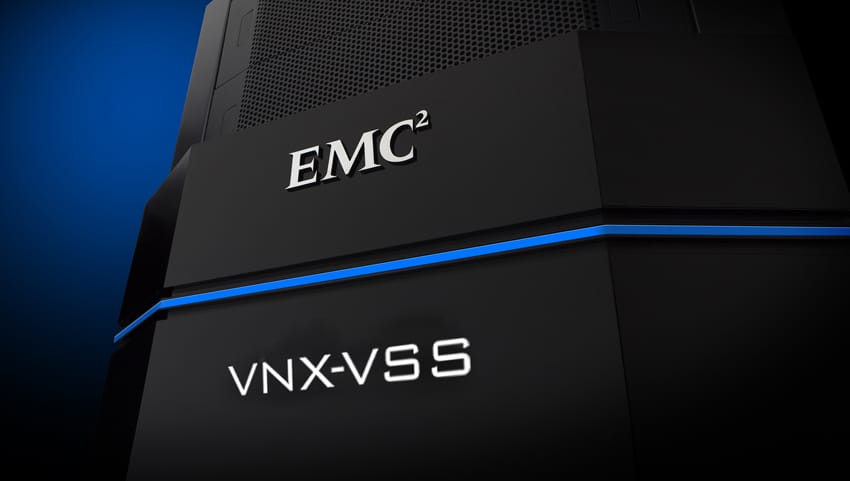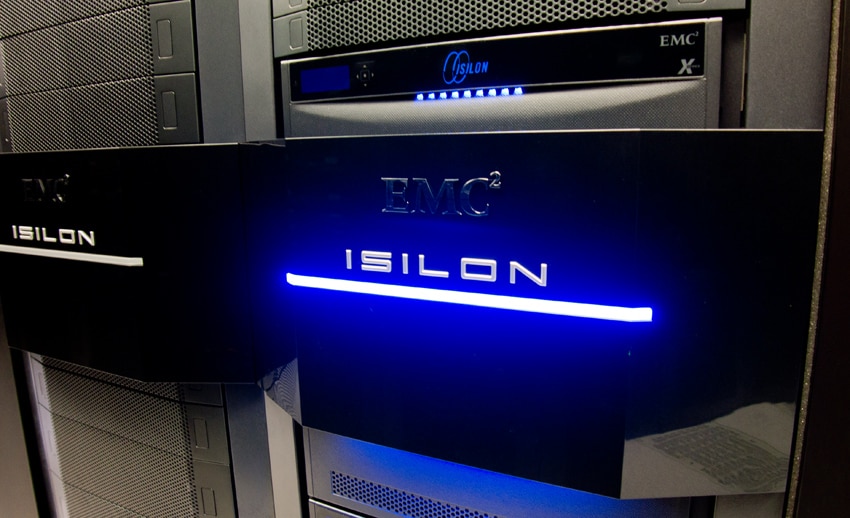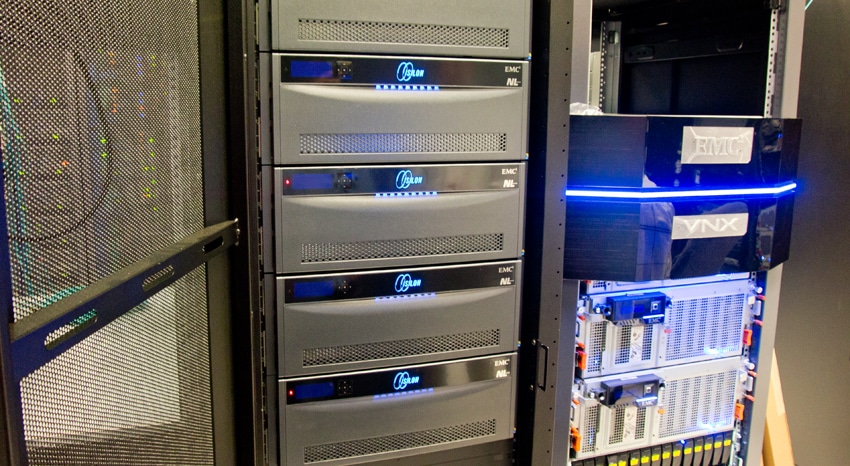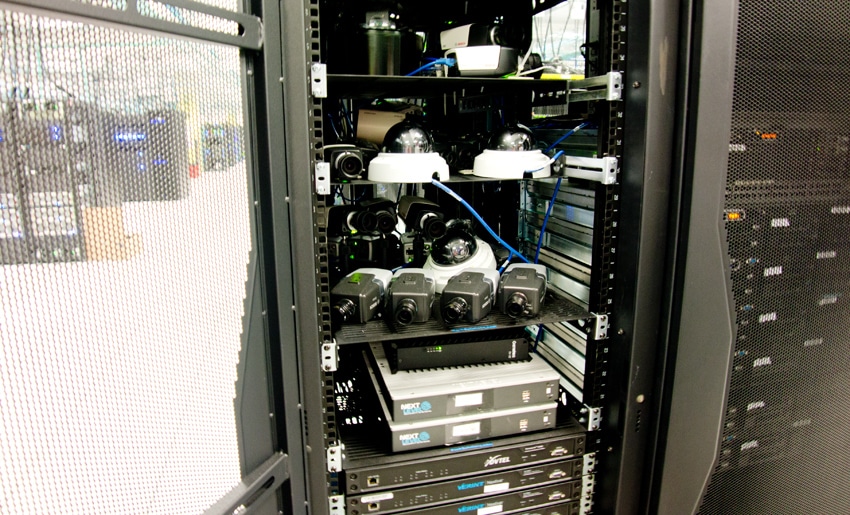
Cameras seem to be everywhere now and the number is only increasing. The omnipresent surveillance can be seen as either a blessing or a curse depending on one’s perspective, but it does provide information that can lead to finding answers to crimes, accidents, and mechanical failures. As camera technology is improving, with aspects such as better resolution, more and more data is being consumed. Surveillance data needs to be stored within a given time frame and with certain retention policies while at the same time video has to be accessed clearly and reliably when a request is sent. EMC sees these and coming concerns and is beefing up its own line of surveillance offerings, and products that serve the surveillance requirements or municipalities, events and large enterprises with complex needs and heavy compliance concerns.

EMC's surveillance effort is interesting in that it's a cross functional team that touches a lot of the EMC portfolio. At the scale EMC deals with, they leverage a hub and spoke architecture that includes elements from the VNX, Isilon and cloud portfolios. EMC benefits from the strengths of each, along with deep integrations with software and camera/hardware providers to deliver a comprehensive solution to their customers. Much of the validation work for these systems and components occurs in a dedicated section of the Durham Center of Excellence, which we visited last year. The surveillance team uses that lab to deploy proofs of concept for customers and they routinely test out the latest cameras and surveillance software builds.
EMC has a somewhat philosophical view on surveillance in that they see it as an element of a broader security strategy more than a single product or stand alone solution. Things like access control, data protection, cyber threat management and so on are all parts of the more broad security spectrum that video surveillance plays a role in. Video is also playing an increasingly important role outside of security too, when it comes to business efficiency, liability protection, BI, workflow analysis and more. Video data really becomes part of the wider scope that is the Internet of Things. The big difference though is while a typical sensor that's connected delivers bits and bytes of data, video has a massive footprint that needs to be handled in new and creative ways.
What's interesting is even as the need for video feeds explodes and the use cases to leverage the data become more evident, the industry is still highly fragmented. No one vendor or integrator owns more than 15% of the market and the variety/quality of solutions available varies widely depending on who's selling it. What's also interesting about this market is that most purchases aren't going through typical IT channels, they're going thorough security system integrators and security distributors, which to typical storage buyers is a very different animal. To that end, EMC is looking to facilitate their vision of edge to core to cloud strategy by helping integrators and distributors go to market with industry validated storage systems that enterprise IT/storage buyers understand and are more likely to support in the buying process.
The edge to core strategy aligns well with what's going on in the wild with enterprises and municipal needs. The use cases are obvious, every few days the news tells us about body cams, traffic cams and other distributed video systems. Pair those with standard video security cameras at government sites and even a small rural county in the Midwest has a lot to manage. Large enterprises are no different, with the need for dashcams, physical site security cameras and the like driving massive data footprints that are geographically widespread. And don't forget, all of this capture has to happen while providing live stream access for monitoring in real time. As regulations require longer archives to be kept and some needs include failover and replication, the surveillance systems of old aren't keeping up.
EMC's solutions includes systems for both the edge and core, along with cloud integration. The VNX-VSS100 addresses needs at the edge and supports 24TB-480TB configurations. Isilon handles the needs at the core, delivering scale of up to 40PB. Lastly, there are also Vblock configurations that 250TB or more in a converged infrastructure configuration. All of these solutions are generally available now.
VNX-VSS100 specifications
- Form Factor: 3U/array, 8 arrays/rack
- Max Raw Capacity: 480TB
- Min/Max Drives: 6/120
- Drive Type Supported: 3.5” NL-SAS
- Interface: 6Gb/s SAS
- Drive Supported:
- 4TB, 7200 PRM
- 15 Drives per Array
- CPU per Array: 16 GB Intel Xeon 5600
- IO Ports per Array: 4 FC ports or 2 FC ports/SP
- 1GB iSCSI Max Total Ports per Array: 8
- 6Gb/s SAS Buses per Array: 2
- Management: LAN 2x 10/100/1000 Copper GbE
- RAID Options: 5 & 6
- Max San Hosts: 2,048
- Max Number Of Pools: 20
- Max Number Of LUNs: 2,048
- Max LUN Size: 16TB (Virtual Pool LUN)
- OS Support: Block OSes
- Supported Protocols & Software Facilities:
- Block Protocols: iSCSI, Fibre Channel (FCP SCSI-3)
- Common Criteria Certification: EAL 3+ Assurance Level
- Lightweight Directory Access Protocol (LDAP)
- Network Data Management Protocol (NDMP) v1-v4
- Network Information Service (NIS) Client
- Routing Information Protocol (RIP) v1-v2
- Simple Network Management Protocol V1-V3 (SNMP)
- Virtual LAN (IEEE 802.1q)
- Software:
- Management: Unisphere for Block, Unisphere Central
- Protocols: iSCSI, FC
- Base Software: EMC Virtual Provisioning, CLI
- Virtualization Support: VMware integrations (vSphere, VASA, VAAI) Microsoft integrations (Hyper-V, ODX, SCM)
- Enclosure:
- Form Factor: 40U
- AC Line Voltage: 200 to 240 Vac ± 10%, single-phase, 47 to 63 Hz
- Power Configuration: Two power domains (base and extended), each redundant
- Power Inlet Count: Either two (for redundant base configuration) or four (for redundant extended configuration)
- Plug Types: NEMA L6-30P or IEC309-332 P6 or IP57 (Australia)
- Input Power Capacity
- 4,800 VA @ 200 Vac
- 5,760 VA @ 240 Vac (base configuration)
- 9,600 VA @ 200 Vac
- 11,520 VA @ 240 Vac (extended configuration)
- AC Protection 30 A site circuit breakers on each power branch
- 40U Cabinet Dimensions
- Height – 75 in (190.8 cm); Width – 24.0 in (61.1 cm); Depth – 39.0 in (99.2 cm); Weight Empty – 380 lbs. (173 kg)
Late in 2014 EMC brought to market the VNX-VSS100, which is a purpose-built video target appliance for the edge. Built on proven VNX technology, the VSS100 is tuned specifically for this workload with an emphasis on simplicity of deployment. The VSS100 has also been validated with several video management software providers including Aimetis, DVTEL, Genetec, Milestone, Next Level Security Systems (NLSS), OnSSI, and Verint, meaning is slips into existing environments without any compatibility concerns. The VSS also comes with Unisphere management software making it easy to manage remotely for distributed organizations. The VSS easily integrates with virtualized environments such as VMware and Hyper-V and while the VNX-VSS can come in a 40U rack and scale to 480TB, the 3U units can easily slot in with existing IT infrastructure.
Storing data at the edge is generally only thought of as a temporary repository. While data can be analyzed and compressed at the edge, it is not generally thought of as the most efficient spot to do it and edge data is often less valuable if not aggregated with the rest of an organization's video assets. Video data is massive though and while 480TB sounds like plenty of capacity at the edge, it can quickly fill up. For managing data on longer-term storage and analysis, EMC uses different models of its Scale-out NAS Isilon series in the core.
The Isilon series has been around for seven generations proving its abilities out. It has built in data protection and availability. Isilon offers more than enough capacity for most, with models scaling as high as 40PB. To make selecting the correct NAS easier on enterprises, EMC offers preconfigured Isilon specifically for video surveillance. These units include:
- Isilon X400 – 720 TB: supporting 250 cameras at 1080p and 30 days retention
- Isilon X400 – 1.4 PB: supporting 500 cameras at 1080p and 30 days retention
- Isilon X400 – 2.5 PB: supporting 1,000 cameras at 1080p and 30 days retention
With EMC Isilon, users can easily add cameras when needed, change camera resolution, and change the data retention time. These abilities are ideal for a growing company or a company that plans on either physically enlarging their area to monitor or a security company taking on more clients. Along with this, users can easily add blocks of storage to the Isilon as the needs for capacity increase and they will find it as easy to manage as the VSS. Further, customers can leverage EMC's cloud connection to offload video files for archive or longer term retention needs.
EMC Surveillance Validation
The emphasis around EMC's surveillance solutions is clearly hardware driven, storage is the underpinning that makes surveillance ultimately work. It's important to understand though that EMC doesn't have a surveillance software package nor do they manufacture and sell cameras. There are several well-established software vendors and the cameras available is a list that's too long to even contemplate; there's a camera for literally every possible need. To make sure their storage systems work well with as many of these software and camera vendors possible, EMC relies heavily on their Durham lab.
Within the Durham datacenter, the EMC surveillance group has a section dedicated to validation and proofs of concept for customers. They believe it to be the largest lab dedicated to surveillance and it generates thousands of high-red video feeds. The idea is to test products to failure if possible, to ensure customer-delivered solutions are solid.
Testing includes a wide variety of EMC hardware including both VNX-based solutions as well as Isilon configurations that are both new like the X400 solutions as well as legacy systems that many customers have deployed today.
Above is a single rack that's loaded full of dozens of cameras that are constantly shooting and feeding data to the storage systems. This is done for both compatibility and stress testing for software, compute and storage.
The end result of all this work are technical papers on best practices, compatibility guides, sizing guidelines, and reference architectures to help integrators design and deploy appropriate infrastructures.
Conclusion
EMC's surveillance practice is really interesting. They've found a niche that's rapidly expanding and while they had both big and small Isilon products to meet the past needs of the market, they saw an opportunity at the edge and exploited it with the VSS100. The VSS provides a cost effective edge solution that integrates back to Isilon at the core and even the cloud for long-term retention if needed. It's a cost-effective solution that operates on the VNX platform that IT departments know and understand. That's not always the case with surveillance gear that tends to be a hodgepodge of NAS, dedicated video recording appliances and stitched together components.
For their part EMC not only has a proved solution now for the edge, but they have the validation that is just as important. The dedicated team with a lab in Durham does everything they can to ensure compatibility, along with providing a deep database of best practices and reference designs to support the distribution channel and end customers. Further they integrate with most major surveillance software packages and have validated these solutions, providing further confidence that the EMC systems will just work. Ease of deployment is critical in this market, especially at the edge where technical resources may be limited. Couple this with Unisphere for remote management and storage admins should be content especially given some of the less hardened alternatives.
EMC says their commitment to surveillance is industry leading in terms of scale of the team and validation effort. That's not something we're in position to validate, but given our time in Durham interviewing the team and getting hands-on with some of the gear, it's certainly hard to argue the point. The net offering is impressively deep and comprehensive, setting EMC up as a clear leader in the video surveillance space.
EMC Durham Center Of Excellence Overview
Sign up for the StorageReview newsletter




